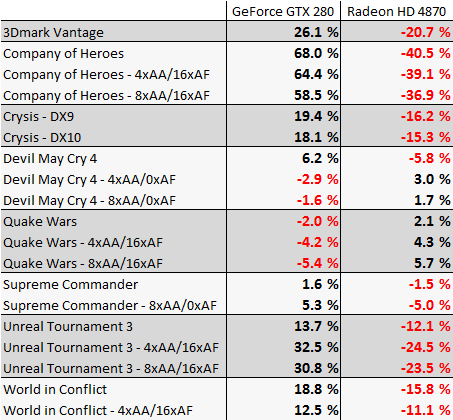Final Thoughts
First let's summarize the performance of these products, as the pricing seems to be set in concrete now after many adjustments over the past few weeks.
Although the GeForce GTX 280 and Radeon HD 4870 graphics cards are not placed within the same price range, we thought it would be interesting to analyze their results anyway.

As you can see, for the most part the more expensive GeForce GTX 280 was faster, though if we were to ignore the Company of Heroes results where the Radeon HD 4870 got creamed, the GeForce GTX 280 wasn't too much faster.
For example, in Crysis and World in Conflict the GeForce GTX 280 was less than 20% faster, Supreme Commander showed a ~5% performance margin, while it was up to 30% faster in Unreal Tournament 3.
Considering that the GeForce GTX 280 costs a little over 30% more than the Radeon HD 4870, you could say that the performance vs. price ratio of these graphics cards is very much the same. This is quite interesting, and with that comparison in hand, we are now keen to check out how the Radeon HD 4870 matched up against the GeForce GTX 260, which is priced within the same range.

This has to be the main head-to-head battle, as both cards pricing are hovering around the $299 mark. As you can see, the results are rather balanced. The GeForce GTX 260 is on average 32% faster in Company of Heroes, whereas the Radeon HD 4870 is on average 42% faster in Quake Wars. The Radeon HD 4870 was up to 19% faster in Devil May Cry 4 and 7% in Supreme Commander, while the World in Conflict and Crysis performance was much the same on either card.
While the Radeon HD 4870 seems to get the better of the exchanges, we think it is safe to say that overall the performance is much the same between these two $299 graphics cards.
Now, for a final closing analysis of the GeForce GTX 260 versus the Radeon HD 4850 (which is ~30% cheaper).

Clearly the GeForce GTX 260 is a superior performer when compared to the Radeon HD 4850, though when you take value into account the performance vs. price ratio is very close.
The Radeon HD 4850 did cop a hiding in Company of Heroes and Unreal Tournament, where it was on average 53% and 48% slower, respectively. However games like Crysis, saw the GeForce GTX 260 produce smaller leads.
Heavily reducing prices of the GeForce GTX 200 series was a smart and necessary move by Nvidia, who reacted very quickly to the storm brought by the AMD/ATI team. Now at $399 the GeForce GTX 280 does very well compared to the $299 Radeon HD 4870. Certainly we are waiting to see how the dual GPU Radeon HD 4870 X2 can perform and how it will compete in pricing against the GTX 280 or anything else Nvidia decides to throw at it.
Those on more of a strict budget will love what the Radeon HD 4850 has to offer at $199, and when it comes to ultimate gaming value this one is hard to beat.
The real clash today between the GeForce GTX 260 and the Radeon HD 4870 ended up with no definite winner. Nvidia and ATI fans can argue all day, but there is no real way to settle it, unless of course you hand pick the benchmarks to your preference. Where the Radeon HD 4870 falls down a bit is on its idle power consumption and operating temperature levels, though the most hardcore enthusiasts will find this a non-issue when installing a relatively cheap aftermarket cooler.